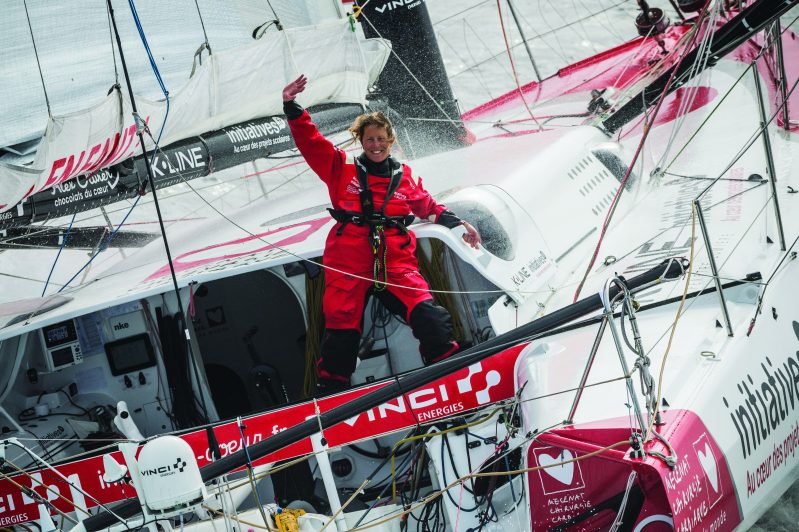Water World
Water World
Share
From synchronised swimming as a child to sailing powerful boats in some of the most inhospitable places on earth, Sam Davies has always loved life on the water. And as the Rolex Fastnet race proves, you need to fit in mind and body. Here’s the first of a regular series with those conquering life through amazing feats.
Tell us about the Rolex Fastnet race and what’s involved…
It’s a famous English offshore race, the biggest in the UK. It starts in Cowes and you race around the south coast to and around Fastnet Rock, and back to Plymouth. It’s 600 nautical miles and open to everybody. The winning boat will probably do it in about 24 hours, others will take more than a week.
In terms of impact on the body, what does it involve?
The hardest thing is the lack of sleep, though it’s not so prevalent in this race. The boat goes so fast that the noise and vibration make it quite hard, so forcing your body to sleep in those conditions if difficult, and you’re usually in wet clothing too because you’re always on call to react to anything that needs sorting out. The struggle is maintaining a high percentage of performance and preserving energy.
How do you train for a race?
There’s a lot of training on land and on water. It’s not just about training yourself physically and mentally, though that’s important, it’s about being weather experts and technical experts too, and making critical decisions when deprived of sleep.
I also work with a core stability coach and do a lot of pilates to protect my body. Yoga is very good to stretch back out again. I’m a sporty kind of person, so I do a lot of fun stuff like open water swimming and running.
Is it hard to make decisions when tired?
We simulate it in training. It’s hard to prepare on land, so we do it on sea when we have the adrenalin and when your survival instincts kick in. Decision making on two hours sleep is hard; your brain acts as though it’s drunk.
What endurance training do you do?
In winter we do a lot of physical training. We launch the boats in spring, so a lot of the hard work is done before then and the weight training reduces throughout the season. I also work with a core stability coach and do a lot of pilates to protect my body. Yoga is very good to stretch back out again. I’m a sporty kind of person, so I do a lot of fun stuff like open water swimming and running.
What about nutrition before and during races? It must be hard eating well in the longer races when you’re competing for weeks?
We have to be careful with what we eat all year round. Movement on the boat can be violent so hard to prepare meals, so cooking with hot water is difficult when jumping in 4m metre waves! All our food is freeze dried or can be reheated in a little pot of water. I like to use brands with natural and organic ingredients to try and optimise what’s going into my body. I eat a lot of nuts and dried food for energy. We can use up to 4000 calories a day, which is a lot to replace. And we obviously eat more the less we sleep, so it’s trying to east as well as you can.

How did you get into it?
My grandparents were sailors. One grandad was a sub commander in the war, the other had a boat yard and raced powerboats. Both my parents grew up around the ocean and water, so I was always dragged on boats when I was a kid. I grew up on the Solent and always saw the cool races. I have a degree in engineering too, so the high-tech boats intrigued me. Initially I wanted to be involved with offshore yacht racing as a designer or engineer, but now I’m doing the actual racing. I used to be a strong swimmer so I joined a synchronised swimming club when I was younger. I swam for Hampshire and did the UK nationals every year until 17/18. I did a lot of rowing at uni.
You must need a lot of mental strength?
It’s one of my strengths, but I try and optimise it by using hypnosis, which has huge benefits for sport. It can relax the mind in periods of stress, pre-race or when things get tough.
What’s the most inhospitable part of the world you’ve raced in?
The Southern Ocean. That’s where we see the strongest waves and biggest winds. No-one can rescue you there as you’re out of reach of helicopters. If something goes wrong between Cape Horn and New Zealand, it’s down to you. You’re closer to the International Space Station than anyone else.
And you raise money for charity, too?
I’m doing all of this to try and save lives. The Mécénat Chirurgie Cardiaque Enfants du Monde project involves my sponsors donating their sponsor space on the boat to our charity. And the more fans I have following me on social media, the more my sponsors donate to charity. For every new follower, they donate a Euro, one click, one heart. The charity itself identifies kids in poor countries with heart defects, and brings them to France to get surgery.
Sam Davies is a Musto ambassador
www.musto.com













FOLLOW BESTFIT